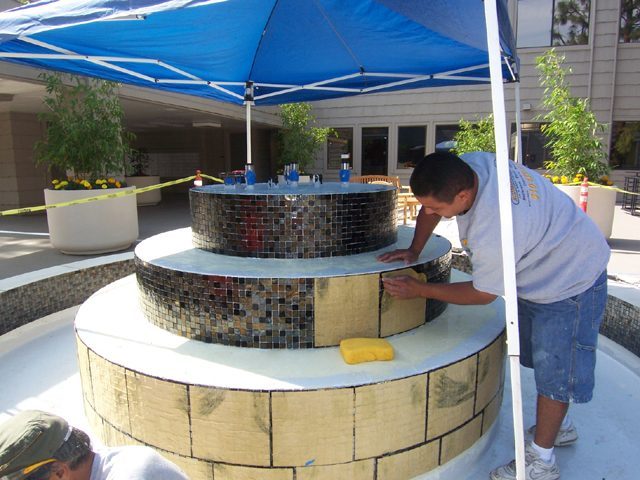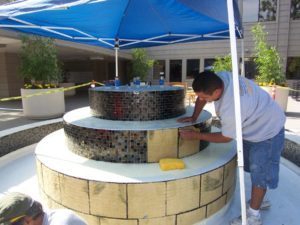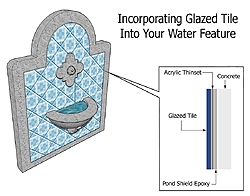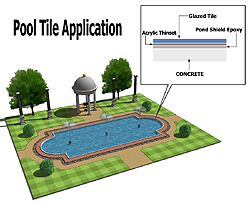
These days, people are just not satisfied with a typical, run of the mill,  boring looking pond. I have seen a wide variety of styles and designs in my time and what I have concluded is that as we progress towards the future, so does the look and feel of the backyard pond.
boring looking pond. I have seen a wide variety of styles and designs in my time and what I have concluded is that as we progress towards the future, so does the look and feel of the backyard pond.
Backyard ponds are not the only things changing either. People are now putting ponds directly in their homes too. In doing so they find that they want to make their pond meld in with its surroundings, as though it was supposed to be there.
One of those ways is to incorporate glazed tile into their motif.  Unfortunately, what usually happens is the glazed tile is put in place and then the waterproofing is addressed. This is a very common and avoidable mistake.
Unfortunately, what usually happens is the glazed tile is put in place and then the waterproofing is addressed. This is a very common and avoidable mistake.
The problem with glazed or glass fired tile is the shiny, smooth surface it has. Coatings just do not stick to this type of surface. Attempting to do so may initially show signs of success, but any coating will eventually fall off.
What you end up with is the coating bonding to the grouted areas of the surface but popping off of the glazed areas. This will more than likely happen to all areas that are glazed. In the end, you will have a raggedy edge of the coating that’s left on the glaze that produces quite an unsightly appearance.
I have been asked if just the grout can be coated. In my opinion, this is not only a labor-intensive task, but one due to failure as well because you’ll more than likely get coating on the glazed surface at some points. When you do, these areas will deteriorate and you will end up with the same unattractive look.
So what is the fix for a scenario like this? Well if you have already installed your tile, the bad news is there is no cure. You will have to remove the tile and get the Pond Shield epoxy coating installed first and then reinstall the tile.

Once the coating has cured, you can sand it with 60-grit sandpaper. This will give the surface of the coating some tooth so that the material you use to attach the tile with sticks to the coating.
Here is where you need to be careful. Usually, tile is attached to a surface using a typical cementitious thin-set that is essentially a very fine cement powder mixed with water. Once it is mixed, it has the same sort of properties as mortar but is much more refined like plaster.
The problem is that typical thin-set will not adhere to a coating. Instead, you’ll want to set your tile in place with a very sticky, acrylic type of thin-set or a polyurethane adhesive such as Ultra-Set by Bostik. These materials are stickier than normal Thin-set. Combined with the tooth you just gave the coating, either of these materials will bond the tile to the coating.
Once this is done, grout the tile as you normally would and you will be in business. The final product places the waterproof barrier behind the tile, while allowing the tile to still be bonded in place, giving you a new design aspect for your pond.
Just think of the possibilities. If you take a look at the wedding cake styled fountain in the pictures gallery, you will see the process actually taking place. In this scenario, the installer was constructing a wedding cake fountain from precast concrete wedges.
The wedges were then assembled and coated with Pond Shield epoxy. The surface was abraded and the black glass tile was set in place with the acrylic thin-set. The whole process only took the installer a few days and the finished fountain has become the centerpiece of the shopping area where it is located.


